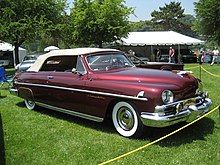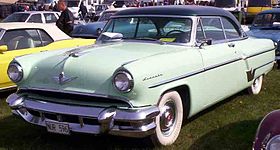Lincoln Cosmopolitan
| Lincoln Cosmopolitan | |
|---|---|
 | |
| Overview | |
| Manufacturer | Lincoln (Ford)[1] |
| Production | 1948–1954 |
| Body and chassis | |
| Class | full-size luxury car |
| Layout | FR layout[1] |
| Chronology | |
| Predecessor | Lincoln EL-series |
| Successor | Lincoln Premiere (sedan) Lincoln Capri (coupe) |
The Lincoln Cosmopolitan is a full-size luxury car that was sold by Lincoln from the 1949 through the 1954 model year.[1] All Lincolns were manufactured at Lincoln Assembly, Dearborn, Michigan, while some were sent in "knock-down kits" to regional factories at Maywood Assembly, Maywood, California, Edison Assembly, Edison, New Jersey, or St. Louis Assembly, St.Louis, Missouri, and assembled locally.
First generation (1949-1951)
| Generation one | |
|---|---|
 | |
| Overview | |
| Model years | 1949–1951 |
| Assembly | Maywood Assembly, Maywood, California, United States[1] Lincoln Assembly, Dearborn, Michigan, United States[1] Edison Assembly, Edison, New Jersey, United States St. Louis Assembly, St.Louis, Missouri, United States[1] |
| Designer | Eugene T. "Bob" Gregorie |
| Body and chassis | |
| Body style | 2-door coupe[1] 2-door Capri coupe[1] 2-door convertible[1] 4 door sedan[1] |
| Powertrain | |
| Engine | 337 cu in (5.5 L) 2-bbl. Flathead V8[1][2] |
| Transmission | 3-speed manual[1] 4-speed Hydra-Matic automatic[1] |
| Dimensions | |
| Wheelbase | 125.0 in (3,175 mm)[1][2][3] |
| Length | 1949: 220.5 in (5,601 mm)[1][2] 1950: 221.2 in (5,618 mm)[1] 1951: 222.5 in (5,652 mm)[1] |
| Width | 1949–50: 77.8 in (1,976 mm) 1950–51: 78.2 in (1,986 mm)[4] |
| Height | 1949–50: 62.7 in (1,593 mm) 1951: 62.6 in (1,590 mm) |
| Curb weight | 4,400–4,800 lb (2,000–2,200 kg) |


In 1949, Lincoln introduced its first postwar bodies, also marking the first product lines of the combined Lincoln-Mercury Division. Although sharing many body panels with the Mercury Eight and the standard Lincoln, the 1949 Lincoln Cosmopolitan was marketed as the flagship of the Lincoln line; the model was distinguished by its own rear roofline.
In a departure from previous Lincoln vehicles, the bodywork featured no running boards, with the fenders and doors enclosed together; the Lincolns featured headlights and taillights recessed ("frenched") into the bodywork. At the time, the styling was referred to as a pontoon design. Using a feature that would later appear in the later Lincoln Continental sedan, all Lincoln-Mercury four-door sedans featured rear-hinged suicide doors. Alongside the four-door, the Cosmopolitan was sold as a two-door (in standard and Capri trim) and two-door convertible.
Sharing its engine with the Ford heavy-truck line, the Lincoln and the Lincoln Cosmopolitan were powered by a 337 cubic-inch Ford Flathead V8,[5] becoming the first Lincoln powered by a V8 engine. Alongside a 3-speed manual transmission, a 4-speed GM Hydramatic automatic was available as an option.[5] For the suspension, the chassis was given front coil springs.[6]

In 1951, on all versions of the Cosmopolitan, Lincoln added power windows and seats as standard equipment.[2]
Alongside the Mercury Eight, the 1949-1951 Lincoln Cosmopolitan would gain popularity among customizers creating "lead sleds".
Second generation (1952-1954)
| Generation two | |
|---|---|
 | |
| Overview | |
| Model years | 1952–1954 |
| Assembly | Maywood Assembly, Maywood, California, United States[1] Edison Assembly, Edison, New Jersey, United States Wixom Assembly, Dearborn, Michigan, United States[1] Wayne, Michigan United States[1] St.Louis, Missouri, United States[1] |
| Designer | Bill Schmidt |
| Body and chassis | |
| Body style | 2-door coupe[1] 4-door sedan[1] |
| Related | Lincoln Capri |
| Powertrain | |
| Engine | 317 cu in (5.2 L) Lincoln Y-block V8[1] |
| Transmission | 4-speed Hydra-Matic automatic[1] |
| Dimensions | |
| Wheelbase | 123.0 in (3,124 mm)[1][2] |
| Length | 1952: 214.0 in (5,436 mm)[1] 1953: 214.1 in (5,438 mm)[1] 1954: 215.0 in (5,461 mm)[1] |
| Width | 77.5 in (1,968 mm) |
| Height | 62.6 in (1,590 mm) |
| Curb weight | 4,300–4,400 lb (2,000–2,000 kg) |
For 1952, the Lincoln-Mercury model line saw a redesign. The Lincoln Cosmopolitan took the place of the standard Lincoln, with the Lincoln Capri becoming the new Lincoln flagship line. Again sharing its body with Mercury (now the Mercury Monterey), the rear body introduced pontoon rear fenders, with the adoption of larger headlamps and taillamps. In a major change, four-door Lincoln-Mercury vehicles saw the introduction of front-hinged rear doors. With the convertible reserved for the Capri range, the Cosmopolitan was now sold as two-door and four-door sedans.
In place of the Ford Flathead V8, for 1952, Lincoln introduced a 317 cubic-inch Lincoln Y-block V8, with the 4-speed Hydramatic as the exclusive transmission.
In 1952 and 1953, Lincolns won the top four spots in the Stock Car category of the Pan American Road Race in both 1952 and 1953. taking first and second place in 1954.[1]
Presidential state car
In 1950, under the Harry S. Truman presidency, legend has it that Truman held a grudge with General Motors because they would not give him use of their cars during his run for the 1948 presidential election; thus, he chose Lincoln for the presidential state car.[7]
The White House leased ten Lincoln Cosmopolitans, built by the Henney Motor Company for Lincoln, and modified by the Hess and Eisenhardt Company. The cars were modified with extra headroom to accommodate the tall silk hats popular at the time, and were painted black. Nine of the automobiles had enclosed bodies, while the tenth was an armored convertible especially for President Truman. The tenth Cosmopolitan was 20 feet (6.1 m) long, 6.5 feet (2.0 m) wide, and weighed 6,500 pounds (2,900 kg), 1,700 pounds (770 kg) heavier than a stock Cosmopolitan. All ten cars were outfitted with 152-horsepower (113 kW) V8 engines "with heavy-duty Hydra-Matic transmissions."[8]
In 1954, President Dwight D. Eisenhower had the Cosmopolitan convertible fitted with a Plexiglas roof that became known as the "Bubble-top"; it remained in presidential service until 1965.
References
- ^ a b c d e f g h i j k l m n o p q r s t u v w x y z aa ab ac ad Kowalke, Ron (1997). Standard Catalog of American Cars 1946-1975. Krause publications. ISBN 0-87341-521-3.
- ^ a b c d e Flory, Jr., J. "Kelly" (2008). American Cars, 1946-1959 Every Model Every Year. McFarland & Company, Inc., Publishers. ISBN 978-0-7864-3229-5.
- ^ "Directory Index: Lincoln/1951_Lincoln/1951_Lincoln_Foldout". Oldcarbrochures.com. Retrieved 2011-11-20.
- ^ "Directory Index: Lincoln/1951_Lincoln/1951_Lincoln_Foldout". Oldcarbrochures.com. Retrieved 2011-12-31.
- ^ a b "Directory Index: Lincoln/1949_Lincoln/1949_Lincoln_Brochure". Oldcarbrochures.com. Retrieved 2011-11-20.
- ^ "Directory Index: Lincoln/1949_Lincoln/1949_Lincoln_Brochure". Oldcarbrochures.com. Retrieved 2011-12-31.
- ^ Huffman, john Pearley (2009-01-19). "The Secret Seven: The Top Presidential Limousines of All Time". Popular Mechanics. Archived from the original on 2015-03-23. Retrieved 2016-02-06.
{{cite web}}: Unknown parameter|dead-url=ignored (|url-status=suggested) (help) - ^ "President Gets New Convertible". Popular Science. 157 (3). Harlan, Iowa: Bonnier Corporation: 158–159. September 1950. ISSN 0161-7370. OCLC 488612811.
- Israelmotorindustry.org. "Lincoln Cosmopolitan 1949 for the Israeli Chief of Staff".
